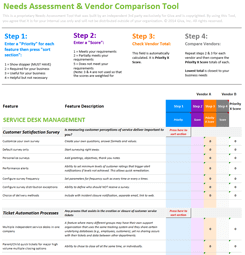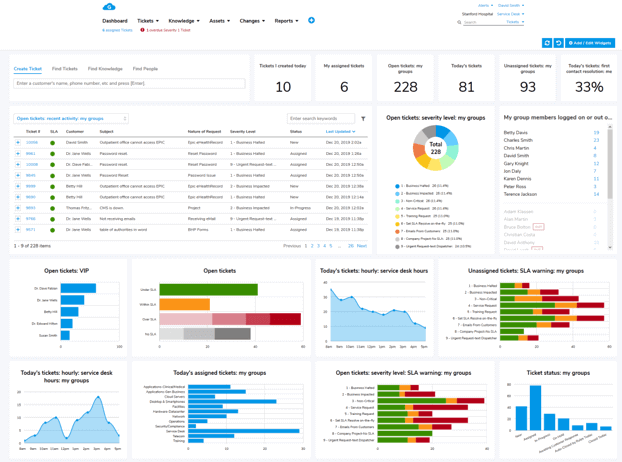IT Cost Management Fully Examined Plus How to Implement Cost Controls
IT cost management is essential for running any modern IT operation. It's also essential for providing IT services for clients.
With IT spending expected to grow 9.8% in 2025, CIOs and CTOs must master the art of strategic cost management while maintaining a competitive advantage and still driving business growth. IBM also acknowledges that CEOs and CFOs are putting more pressure on IT leaders to keep costs down.
In this article, we examine IT cost management in more detail. We provide you with practical steps for keeping your team's IT costs under control.

What is IT Cost Management?
IT cost management is a comprehensive, strategic approach to understanding, controlling, and optimizing technology-related spending.
This can't be done in isolation. IT cost management needs to be implemented across an organization's entire digital ecosystem. It's much more involved than simply cutting expenses.
What if you cut out a service, subscription, or vendor contract that's mission-critical? Correcting an error like that could cost far more than the original cost.
IT cost management is particularly important for healthcare organizations, financial services firms, and call centers. These organizations are under pressure to get the most from technology investments while keeping costs under control.
Key Aspects of IT Cost Management
- Effective IT cost management involves the careful and continuous examination and analysis of an organization's IT expenses. This includes hardware, software, cloud services, integration, and implementation costs.
- An IT cost management plan serves as a detailed document. It outlines strategies for estimating, allocating, and controlling ongoing IT and project costs. At the same time, technology investments need to be configured to align with business objectives.
- Having a disciplined approach ensures that every dollar spent on technology delivers measurable value. It provides an ROI in one way or another to the organization's bottom line.
- For busy CIOs in healthcare, financial services. and call centers, this discipline becomes particularly critical. They face increased regulatory pressures, customer service demands, and operational complexity. These can't function without sophisticated technology solutions. Advanced tech costs money. But you still can't let costs get out of control. That's what IT cost management is all about.
Meaningful IT cost management extends beyond mere cost reduction. It creates transparency in spending patterns. It empowers data-driven decisions about technology investments. This establishes accountability across IT teams.
What's Changing About IT Cost Management?
IT used to be a capital expenditure (CapEx). But these days, because of SaaS, PaaS, IaaS, and AI, these are operational expenditures (OpEx). They show up in a different place on the balance sheet. This also means new frameworks for budgeting and financial analysis.
This shift means CIOs must develop better approaches to managing variable costs. They also need to understand the true total cost of ownership for cloud solutions.
Keeping costs under control is especially challenging right now. Cloud transformation projects are still underway. Many IT operations are looking at how to integrate AI tools more effectively.
Yet, a practical balance needs to be struck. IT and SaaS (Software as a Service) budgets are bloated enough. They don't need further AI-based complexity. Organizations need to draw a line. IT cost management is one of the most effective ways to do this.
ITSM-Centric IT Cost Management
IT cost management encompasses several critical dimensions for IT Service Management (ITSM) teams. Most of this overlaps and connects with IT Information Library (ITIL) principles.
ITSM cost management covers the following areas:
- Cost allocation mechanisms
- Making sure that technology expenses are properly attributed to specific business units or projects
- Producing an accurate profitability analysis
- Resource planning capabilities
- Anticipating future technology needs and associated costs, like AI
- Performance metrics providing ongoing visibility into cost efficiency and return on investment
Continuous digital transformation and the growing popularity of cloud computing have changed how organizations approach IT cost management.
All of this makes it easier to provide visibility for business leaders, like CEOs and CFOs.
The rest of this article is packed with useful strategies and approaches for managing IT costs more effectively.
8 Ways to Control IT Costs
-
Implement Comprehensive Cloud Cost Management
Cloud cost management has become critical for any IT cost management program. This is especially true for cloud computing systems. Integration and AI-based automation will feature even more prominently in future IT cost management trends.
Organizations must evaluate and adjust cloud SaaS subscriptions based on actual usage patterns. Don't base them on predicted or potential demand.
How to Implement
- Start with a thorough audit of your current cloud resources and apps across every platform. Look for your shadow IT costs, too. These are apps and resources being used by teams or individuals that didn't go through IT procurement channels.
- Implement resource tagging that enables detailed cost tracking by department, project, or application. This could be done in real-time or usage-based, if you can get the right technology.
- Configure automated processes to close down unused apps and resources. Rightsize over-provisioned resources. Many IT organizations find they can reduce cloud costs by 20% to 30%. They do this simply by eliminating waste and optimizing resource allocation, according to Infracost.
-
Leverage SaaS Consolidation and Optimization
For most IT teams, an immediate opportunity for cost savings is via SaaS budget optimization. Strategic consolidation means you replace multiple SaaS solutions with comprehensive platforms. This eliminates redundant licensing fees.
This also reduces integration complexity and minimizes training requirements.
How to Implement
- Conduct a detailed software audit to identify overlapping functionality across your tech stack.
- Create a standardized process for buying and subscribing to software. Include cost-benefit analysis and integration requirements.
- Negotiate enterprise agreements that provide volume discounts and predictable annual costs.
- Take this approach, instead of managing dozens of individual vendor relationships.
-
Automate Manual Processes With AI
As the majority of people in multiple sectors are finding, AI tools are helping us free up time and resources. These can be deployed elsewhere.
When you automate routine IT tasks like system monitoring, backup verification, and report generation, organizations reduce operational costs. They also meet SLA targets more efficiently.
Focus automation efforts on high-volume, repetitive tasks that consume significant staff time. This reduces direct labor costs. It enables IT teams to focus on strategic initiatives that drive real value.
How to Implement
- Identify rule-based processes.
- Then develop clear inputs and outputs for those high-volume, manual tasks. This will justify an AI-based investment.
-
Optimize Network Infrastructure and Hardware Lifecycle Management
Proactive hardware lifecycle management prevents unexpected costs. It also ensures optimal performance. Develop a comprehensive asset management strategy. This strategy should track hardware age, performance metrics, and maintenance costs. Make it easier to deliver predictable capital expenditure planning. It helps avoid emergency replacements that often come at premium prices or are an unexpected capital expense.
How to Implement
- Consider hybrid approaches that balance on-premises (on-prem) infrastructure with cloud services. Base this balance on workload characteristics.
- Some applications benefit from dedicated hardware. Others are more cost-effective in cloud environments. The goal is to match each workload to its most cost-effective platform.
-
Implement Technology Business Management (TBM) frameworks
Technology Business Management (TBM) solutions provide comprehensive access to cost data. They create a cost-to-service flow that identifies and controls IT costs.
TBM frameworks help organizations understand the true cost of IT services. With these, you can make informed decisions about resource allocation.
How to Implement
- Establish service catalogs that clearly define the cost and performance characteristics of different technology services. This transparency enables business units to make informed decisions about their technology consumption. It provides IT leadership with data needed for capacity planning and budget forecasting.
-
Establish Vendor Management Practices
Effective vendor management can significantly impact your organization's cost structure.
How to Implement
- Develop standardized processes for vendor evaluation. Consider the total cost of ownership rather than just the initial purchase price. This includes ongoing maintenance costs, integration requirements, training needs, and potential exit costs.
- Negotiate contracts that include performance guarantees and cost escalation limits. Many technology vendors have raised prices significantly in recent years. This makes it essential to secure predictable pricing through multi-year agreements where appropriate.
-
Do a Total Cost of Ownership (TCO) Analysis
Understanding the true financial impact of IT investments requires looking beyond initial purchase prices. You need to embrace a comprehensive Total Cost of Ownership (TCO) analysis.
This approach provides a complete view of technology investments. It calculates all associated costs throughout the entire lifecycle of a system or solution.
How to Implement
- A thorough TCO evaluation should include more than just the upfront acquisition costs. It should also include ongoing operational expenses. These include maintenance contracts, technical support, training requirements, and integration costs. Don't forget often-overlooked hidden expenses like downtime, security updates, and eventual migration or replacement costs.
- With a detailed TCO analysis, organizations can make well-informed decisions. These decisions account for the full financial commitment of their technology choices. Seemingly affordable solutions may carry substantial long-term financial obligations. These obligations significantly impact the organization's bottom line over time.
-
Develop Strategic Approaches to Technical Debt Management
Old technology often incurs technical debt. This creates expenses that will accumulate over time. A "quick fix" today could cost a fortune tomorrow. Develop systematic approaches to identifying and addressing technical debt.
How to Implement
- Do this before it becomes a significant cost burden. Create detailed cost estimations for any digital transformation or AI integration projects.
- Account for both direct migration costs and potential savings from improved efficiency and reduced maintenance. This analysis helps prioritize technical debt reduction efforts based on their financial impact.
How to Manage Long-Term IT Costs
Here are other ways to manage long-term IT costs:
-
Establish Predictive Cost Modeling
Long-term cost management requires sophisticated forecasting capabilities. These capabilities must account for business growth, technology evolution, and changing requirements.
Develop models that can forecast future costs based on your ITSM, business, and product roadmap. Factor in any anticipated business changes. These models should incorporate both fixed costs and variable costs. This provides accurate projections across different growth scenarios.
-
Implement Continuous Cost Optimization Processes
IT cost management is not a one-time activity. It is an ongoing discipline. Establish regular review cycles that evaluate cost performance against budgets.
Identify emerging optimization opportunities. There are always going to be new ways to optimize your IT resources efficiently. Create feedback loops that capture lessons learned from cost management initiatives. Apply them to future planning cycles.
-
Build Organizational Cost Awareness
Create transparency around IT costs throughout the organization. Don't limit this to the IT team, IT leaders, and CFO. When business users understand the true cost of technology services, they make more informed decisions about what they use and how it's used.
Better IT cost awareness naturally drives demand-side optimization. This complements supply-side cost management efforts.
-
Develop Scenario-based Planning
Create multiple cost scenarios that account for different business conditions and technology trends. This approach enables proactive adjustments to changing circumstances.
It avoids reactive cost-cutting that can damage operational capabilities. Include scenarios for economic downturns, rapid growth, and major technology shifts in your planning processes.
Now, let's look at the benefits of more effectively controlling IT costs.
Benefits of IT Cost Management
-
Enhanced Financial Performance
Reducing IT-related costs directly Improves the organization's bottom line. This, in turn, betters a company's overall financial condition. These savings create capital that can be reinvested in innovation projects. These projects drive competitive advantage.
-
Improved IT Alignment With Business Goals
Effective cost management creates clear connections between technology investments and business objectives.
When IT spending is properly allocated and tracked, organizations can measure the return on investment for different technology initiatives.
-
Increased Operational Efficiency
Systematic IT cost management identifies and eliminates unnecessary expenses. It optimizes IT resource utilization. Organizations achieve greater efficiency by rightsizing their technology infrastructure.
Eliminate redundant systems and automate manual processes. This optimization liberates resources for strategic initiatives that generate operational growth.
-
Enhanced Financial Stability
Cost management tools provide a real-time view of project expenses. This enables informed adjustments to keep costs within budget. Better visibility supports data-driven decisions about tech stack investments.
It helps prevent budget overruns that can destabilize project timelines and organizational finances. A proactive approach to cost management serves as a cornerstone of successful project management. It also produces long-term financial stability.
4 Practical Ways to Manage IT Cost Management
Here are ways you can implement IT cost management right away.
-
IT Cost Management Software
Selecting and implementing the right IT cost management software involves several steps. Assess your organization's specific needs. Compare features across available solutions.
Ensure seamless integration with existing systems, like your IT Help Desk. Modern cost management tools enable organizations to take control of their finances. They offer insights into spending patterns, forecast future expenses, and identify cost-saving opportunities.
Some examples of IT cost management software include the following:
-
IT Cost Management Process
Start with creating an accurate inventory of your IT landscape. You also need to establish baseline cost measurements.
Effective processes include regular cost reviews and variance analysis between budgeted and actual costs. This should also include continuous optimization based on performance metrics.
Make the process documented, repeatable, and integrated with broader financial planning cycles. This brings consistency and accountability.
-
Develop Organizational Capabilities
Successful IT cost management is about much more than just tools, processes, and spreadsheets.
Organizations need to develop internal capabilities, including:
- Financial analysis skills
- Vendor negotiation expertise
- Strategic planning competencies
This often involves training existing staff, hiring specialized talent, or partnering with external experts. These experts can provide guidance during implementation phases.
The most successful organizations create centers of excellence. These centers combine IT expertise with financial knowledge. These teams serve as internal consultants who can evaluate technology investments. They optimize existing costs and guide complex procurement decisions.
-
Measuring Success and Continuous Improvement
Establish clear metrics for measuring the success of your cost management initiatives. These should include both absolute cost reductions and efficiency improvements. Measure efficiency through metrics like:
- Cost per user
- Cost per transaction
- Cost of service delivered
- Total Cost of Ownership (TCO)
Regular measurement enables continuous improvement. It helps demonstrate the value of cost management investments to organizational leadership.
Effective processes include regular cost reviews and variance analysis between budgeted and actual costs.
Future Outlook of IT Cost Management
The future of IT cost management will use AI, ML (machine learning), and advanced analytics. These solutions can predict cost trends more accurately. AIs, particularly AI agents, can automatically improve resource use.
They can suggest cost improvements, which IT leaders can then confirm or deny. Organizations that start using these tools today will succeed better as technology becomes even more complex. Just make sure that no buying or contract termination decisions are made without human input. AIs won't understand every detail or the human reasons behind specific business decisions.
IT Cost Management Resources
- Standalone IT Change Management Software by Giva
- IT Asset Management (ITAM) in the Cloud
- The 14 Best ITSM Software Tools for 2025: Buyer's Guide
- The 20 Best IT Change Management Software Tools for 2025
- Free Software Needs Analysis and Assessment Tools: Useful for evaluating vendors and costs
Giva Can Help Streamline Your ITSM Processes and Help Cut IT Costs
Giva's IT Service Management Software is AI Powered and HIPAA Compliant.
Giva orchestrates IT harmony for all and is your trusted guide. Full ITIL® compliance, or just some — either way we make it easy:
- Onboard rapidly and get expert support for immediate success
- Enhance user autonomy with self-service and knowledgebase solutions
- Make fast business decisions with deep and comprehensive out-of-box reporting and analytics
- Boost visibility and productivity with real-time dashboards and AI Copilots
Get a demo to see Giva's solutions in action, or start your own free, 30-day trial today!





